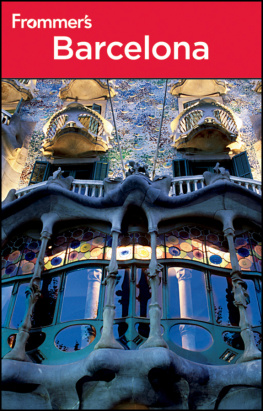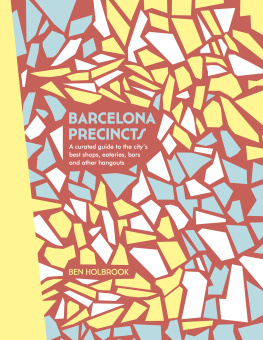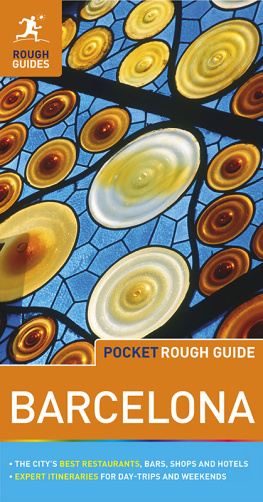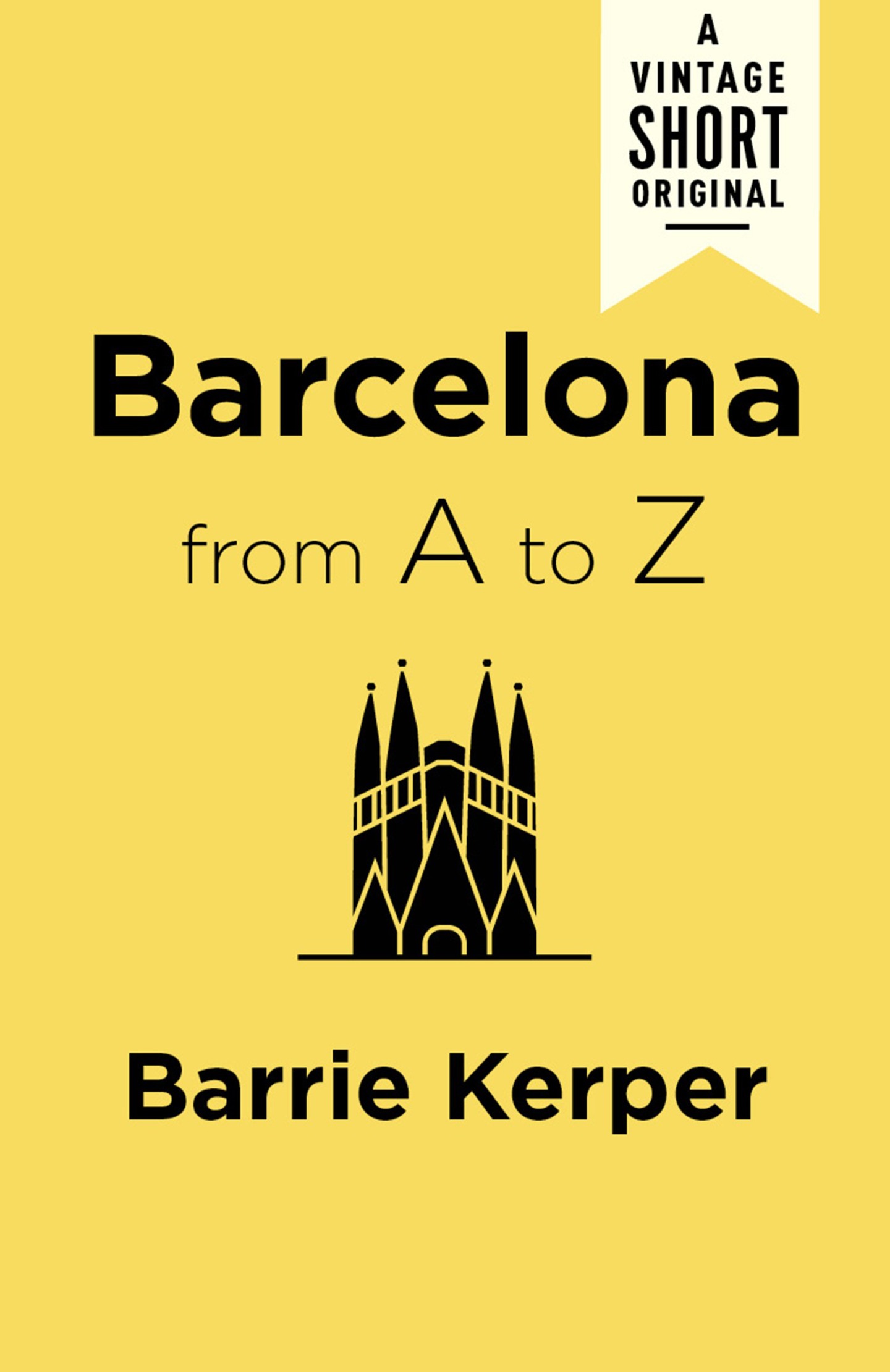Barrie Kerper
Barcelona from A to Z
Barrie Kerper is an avid traveler and has filled up four passports. She is the author of the Collected Traveler series and loves to drink cava in Barcelona.
Barcelona from A to Z
Barrie Kerper
A Vintage Short
Vintage Books
A Division of Penguin Random House LLC
New York
Copyright 2017 by Barrie Kerper
All rights reserved. Published in the United States by Vintage Books, a division of Penguin Random House LLC, New York, and distributed in Canada by Random House of Canada, a division of Penguin Random House Canada Limited, Toronto.
Vintage and colophon are registered trademarks of Penguin Random House LLC.
The Cataloging-in-Publication Data for Barcelona from A to Z is available from the Library of Congress.
Vintage Books eShort ISBN9780525432524
Cover design by Mark Abrams
www.vintagebooks.com
v4.1
ep
Contents
To travel across Spain and finally to reach Barcelona is like drinking a respectable red wine and finishing up with a bottle of champagne. For Barcelona is an exhilarating city, replete with challenging aspects.It is a world almost to itself, a unique metropolis bound more to the Mediterranean than to the mountains, more to France than to Africa.
James A. Michener, Iberia: Spanish Travels and Reflections
Barcelona is an intoxicating ride. One visit is unlikely to be enough.
Lonely Planet Discover Barcelona Guide
Barcelona is one of the most dynamic cities in the world, and the region of Catalonia is remarkably diverse in its geographywith sandy beaches and rocky shores on its coastline, mountain ranges, three major rivers, more than forty vineyards (eleven of which have Product Designation of Origin status, a European Union label that protects the reputation of regional agricultural products), and some of the most important wetland sites in Europe, making for rich experiences to be had throughout.
La Diada de Sant Jordi (Saint Georges Day), celebrated in Barcelona and throughout Catalonia on April 23, seems an appropriate time to publish a book. Heres why: In 1926, in honor of the death of Miguel de Cervantes, Spain officially designated April 23 as Book Day. The date also coincided with the day of the Feast of Sant Jordi, celebrated since the fifteenth century, and as Saint George is also known as the protector of lovers, many Catalonians give one another a rose on this day. So April 23 is simultaneously known as El Dia de la Rosa (Day of the Rose) and El Dia del Llibre (Day of the Book), and if you are in Barcelona it is especially festive: Las Ramblasthe citys most famous streetis lined with book stalls; there is a twenty-four-hour reading of Don Quixote; the Catalan dance, the sardana, is performed on the Plaa Sant Jaume; music performances are held in the Barri Gtic; and its one of the few days of the year when the Palau de la Generalitat is open to the public without an appointment. In 1995, UNESCO designated April 23 World Book and Copyright Day, and it seems fitting to acknowledge the occasion no matter where one lives in the world.
For this introductory guide and directory for those traveling to Barcelona and Catalonia, I have not included all twenty-six letters of the alphabet, but the letters I have chosen introduce words, phrases, culinary specialties, people, historical notes, excursions, and personal favorites of mine. These are all topics that are unique and iconic to Barcelona, Catalonia, or Spain. And this brief miscellany will prove helpful in the anticipation of your upcoming journey, in the enjoyment of your trip while its happening, and in the remembrance of it when youre back home.
Two quotations in particular guided me in compiling this compendium. One was written by a medieval Persian poet, Saadi, who noted in Gulistan (The Rose Garden) that a traveler without knowledge is a bird without wings. The other is by British biographer and travel writer James Pope-Hennessy, who in his wonderful book Aspects of Provence notes that if one is to get best value out of places visited, some skeletal knowledge of their history is necessary.Sight-seeing is by no means the only object of a journey, but it is as unintelligent as it is lazy not to equip ourselves to understand the sights we see. If you immerse yourself in a destination, you will better understand and appreciate the place and the people who live there, and, not surprisingly, youll have more fun. I have long admired encyclopedias, which remind me that the more I know, the more I find out I dont know. When I read about travel in the days before transatlantic flights, I always marvel at the number of steamer trunks and baggage people were accustomed to taking. If I were traveling back then, however, my trunks would have been filled with books, not clothes. Although I typically travel light and seldom check bags, I have been known to fill an entire suitcase with books, secure in the knowledge that Ill have them all with me for the duration of my trip.
The French have a word, dpaysement, that is not easily translated into English, but in an article titled Discovering the Hidden Paris written by John Vinocur for The New York Times years ago he defined the word as the feeling of not being assaulted by the familiarity of things, a change in surroundings where there is no immediate point of reference. Vinocur went on to quote a French journalist who once said, Americans dont travel to be dpayss, but to find a home away from home. I understand that the journalist did not mean this as a compliment, and it is unfortunate that some people can travel all around the world and yet their unwillingness to adapt ensures they will never really leave home; but I also understand that when we land in a new place we all want to become as familiar with it as quickly as we can. We are all, in a way, looking for that home away from home, and the best way to feel comfortable in a new place is to arrive as a knowledgeable visitor. I believe what you get out of a trip is equal only to what you put into it, and this compendium is meant to be an inspired dossier of key facts that I believe will be of interest to armchair travelers, first-time visitors, and those whove been to this part of Spain many times.
Occasionally, someone asks me about combining a visit to Barcelona and Catalonia with forays into the neighboring Basque region, or with Madrid or Andalusia. My reply is that if there is enough time allotted to add on visits elsewhere, fine. But too often people try to cram too many places into too short a period of time. I prefer a strategy of staying longer within a smaller area so as to experience it more fully. Author and travel writer Susan Allen Toth refers to this in England As You Like It, in which she subscribes to the Thumbprint Theory of Travel: One should spend at least a week in one spot no larger than her thumbprint covers on a large-scale map of England.
Excursions are encouraged, as long as theyre about an hours drive away. I have discovered in my own travels that a week in one place, even a spot no bigger than my thumbprint, is rarely long enough to see and enjoy it all. Each of Spains regions deserves to be covered separately, and there is so much to see and do in Cataloniastaying within this particular thumbprint will be very rewarding!
Read, plan, and enjoy, and as the Catalans say, bon viatge! And please visit my blog, www.thecollectedtraveler.blogspot.com , for much, much more about Barcelona and Catalonia.









